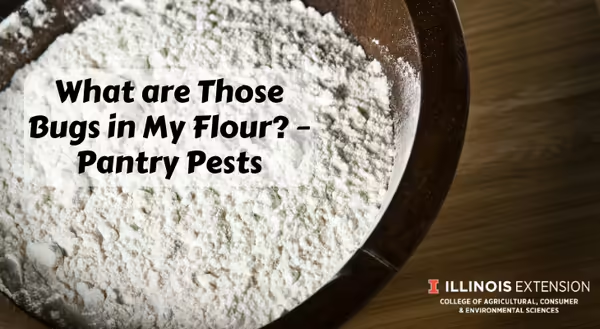
With the holidays approaching, many of us will be doing a lot of baking. Others of us may be buying birdseed to feed our feathered friends this winter. Occasionally some uninvited guests may show up in these products or where you store them - pantry pests. These insects live, eat, and grow inside stored products like birdseed, dry pet food, and dry food products (oatmeal, rice, pasta, flour, chocolate, etc.) as well as other dried plant materials (dried flower arrangements, ornamental corn, etc.). There are a variety of insects that are considered pantry pests. Some of the more commonly encountered include cigarette, drugstore, and flour beetles as well as Indian meal moths.
Cigarette, drugstore, and flour beetles are small (1/8 in) beetles that are reddish-brown with a rounded, oval shape. The heads of cigarette and drugstore beetles are tucked down so that they cannot be seen from above, while the heads of flower beetles can be seen. The larvae of these beetles are hairy and creamy colored.
Indian meal moths are about ½ inch long. They have distinctive wing coloring, making them relatively easy to identify. The part of the wing closest to the body is whitish-gray, while the rest of the wing is coppery colored with black stripes. Caterpillars will grow to be about ½ inch in length and range in color from dirty white to greenish and pinkish. As the caterpillars feed and travel around their food source, they will leave a silken thread behind them, often forming webs across the surface of foods they are infesting. When caterpillars are ready to pupate, they will leave their food source to find a suitable location, often where a wall or ceiling meet (or a similar location on shelving).
There are a variety of different steps that you can take to try and prevent pantry pest infestations:
- Buy dried foods in quantities small enough to be used up in a short time. Use oldest products before newer ones, and opened packages before unopened ones.
- Inspect packages or bulk products before buying. Packages should be sealed and unbroken.
- Store foods in tightly closed glass, metal, or heavy plastic containers. This prevents pantry pests from getting into food, as well as preventing them from getting out of infested foods (they can chew through paper, cardboard, and thin plastic packaging).
- Good sanitation. Keep food storage areas clean by not allowing crumbs or spilled food to accumulate. Remove and discard old, unused products and inspect the remainder. Thoroughly clean cracks and corners.
If you have pantry pests, several control strategies can be taken to eliminate them:
- Inspect all potential food sources. Many are attracted by lights and may be found away from the infested food product.
- Heavily infested items should be thrown away outdoors in a tightly sealed bag.
- If food products are not badly infested, they can be thrown away, or they may be salvaged:
- By freezing at 27°F or colder (colder the better) for at least 3-7 days (the longer, the better)
- Food can be heated at 140°F in an oven for an hour
- Empty and thoroughly vacuum any areas holding infested items. Pay particular attention to cracks, crevices, and corners.
- Empty the vacuum cleaner or discard the vacuum cleaner bag after use to prevent reinfestation
- The use of insecticides is not recommended. Control will only be temporary unless the infestation is eliminated, and they do not affect pests inside of food packages.
- If insecticides are used, READ AND FOLLOW ALL LABEL DIRECTIONS!
- If foods contact insecticides, they must be thrown away!
- Cupboards, containers, and dishes must be thoroughly washed and dried before being used again.
Good Growing Tip of the Week: While we may like to think we don’t have any insects and other ‘creepy crawlies’ (arthropods) in our homes, that’s not the case. Researchers in North Carolina studied homes for the presence of arthropods. They found, on average, 62 different types (families) of arthropods per house.
Want to get notified when new Good Growing posts are available? SIGN UP HERE!
MEET THE AUTHOR
Ken Johnson is a Horticulture Educator with University of Illinois Extension, serving Calhoun, Cass, Greene, Morgan, and Scott counties since 2013. Ken provides horticulture programming with an emphasis on fruit and vegetable production, pest management, and beneficial insects. Through his programming, he aims to increase backyard food production and foster a greater appreciation of insects.